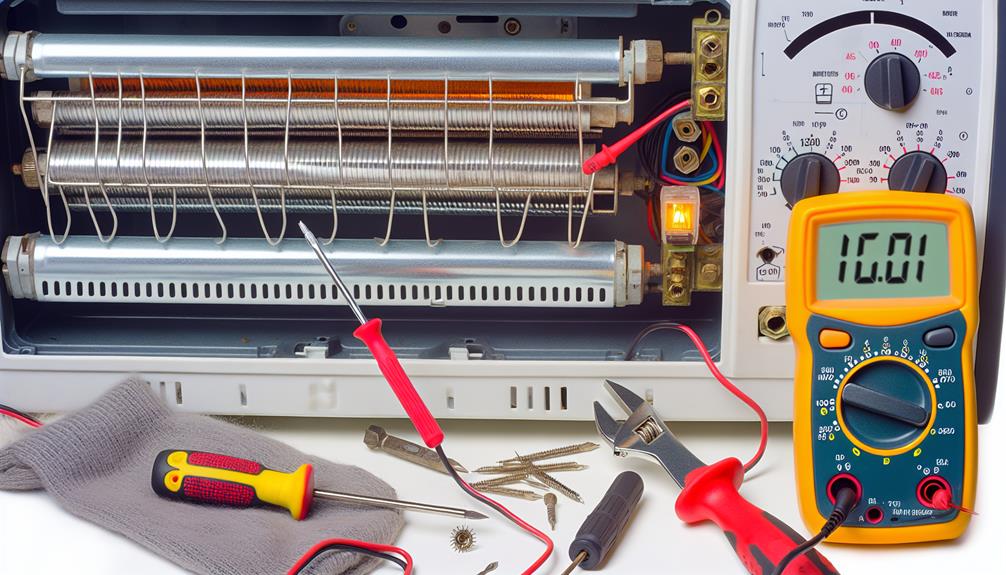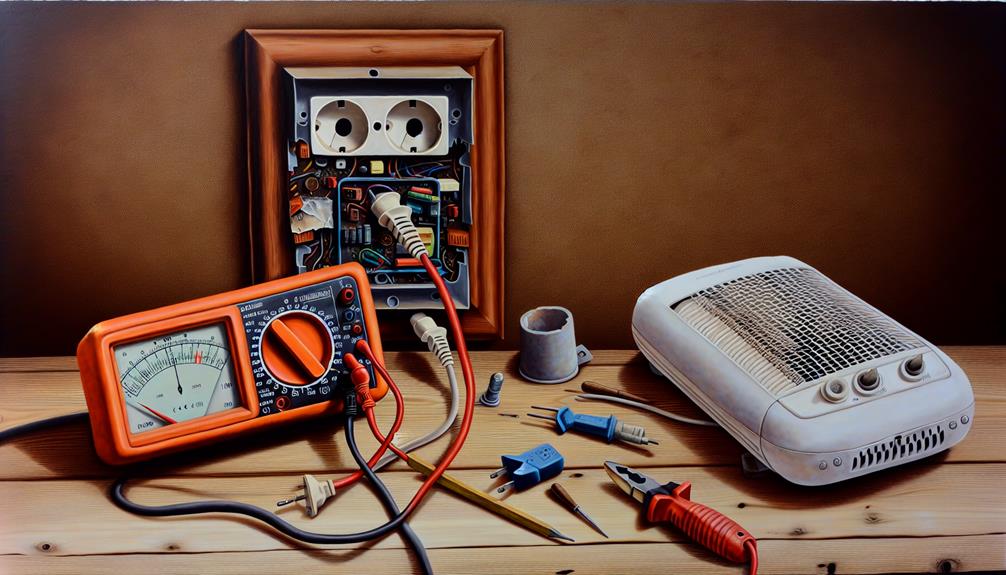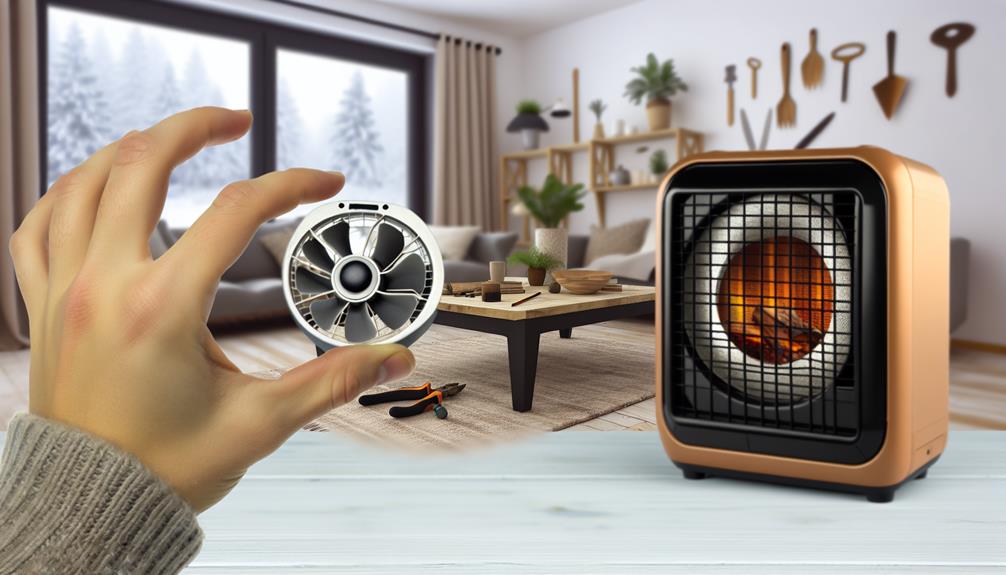As winter's chill creeps into your home, your trusty portable heater might falter, leaving you in the cold—but fear not, for you're not without recourse. You've likely encountered a range of common issues that can often be resolved with a few simple checks and adjustments. By ensuring the power source is secure and inspecting the heating unit for blockages or dust build-up, you might quickly restore warmth to your space. If you're grappling with a stubborn unit that refuses to cooperate, consider this: some problems may be more than meets the eye, and the solution could be as simple as a quick clean or minor tweak. Stay with me as we explore the practical steps you can take to fend off the cold without waiting for a professional, and perhaps learn a thing or two about maintaining your device in optimum condition.
Key Takeaways
- Ensure the power supply is functioning properly, including checking the outlet, circuit breakers, power cord, and amperage.
- Regularly clean and maintain the heater, including cleaning the grates, avoiding water or liquid cleaners, and removing dust accumulation.
- Inspect the power cord for wear or damage, ensure secure connections, and replace damaged cords immediately.
- Troubleshoot the thermostat by verifying it is set correctly, cleaning it, checking for loose connections or damaged wiring, and testing its functionality.
Assessing Power Supply Issues
Before diving into troubleshooting your portable heater, it's crucial to check that the unit is connected to a reliable power source and that all electrical components are in good working order. First, ensure your space heater is plugged into a functioning outlet. A tripped circuit breaker or blown fuse can prevent power from reaching your unit, so inspect your home's electrical panel for any issues and reset or replace as necessary.
Examine the power cord for visible damage or fraying. If you spot any harm, consider using a spare cord if available, as compromised wires can be a safety hazard and impede the heater's performance. Additionally, confirm that the outlet can deliver the required amperage for your space heater and that it matches the heater's power specifications.
Using a multimeter can provide a definitive assessment of the power supply. Check for continuity and ensure voltage levels are consistent with the heater's requirements. Don't forget to test the functionality of built-in safety features like the tip-over switch and high limit safety switch, which can interrupt power if they detect unsafe operating conditions. Finally, verify that the thermostat is set correctly, and observe that the fan and heating element engage without issue.
Cleaning the Heater's Interior
Before you tackle the interior, ensure you've unplugged the heater to prevent any electrical hazards. You'll need to remove dust buildup carefully, as it can hinder your heater's performance by obstructing airflow pathways. Utilize a brush to meticulously clean the grates and maintain proper air circulation.
Unplug Before Cleaning
To ensure your safety and protect the unit, always disconnect your portable heater from the power source before you start cleaning its interior. Let the heater cool down completely to prevent burns or damage. When it's safe to proceed, use a soft, dry cloth or a brush to gently remove dust or debris. Don't introduce water or liquid cleaners, as these can harm the electrical components. If the interior is heavily soiled, it's wise to seek professional cleaning services to avoid damaging the heater.
| Step | Tool | Precaution |
|---|---|---|
| 1 | Unplug before cleaning | Avoid electric shock |
| 2 | Use a vacuum or brush | Prevent damage to components |
| 3 | Professional help for heavy soil | Protect the integrity of the unit |
Remove Dust Accumulation
Regular maintenance, including cleaning the heater's interior to remove dust accumulation, ensures your unit operates efficiently and safely. Dust can impede airflow and trigger the heater's automatic safety shut-off, compromising its functionality. Start by using a dry cloth to remove surface dust from the heater's exterior. For the interior, carefully utilize a vacuum cleaner with a brush attachment to get rid of the dust within the grates. This good cleaning practice not only prevents malfunctions but also maintains the heater's performance. In cases where dust buildup is substantial and beyond the scope of routine care, consider seeking professional cleaning services to ensure a thorough job and to avoid damaging your unit. Always prioritize safety and effectiveness through diligent maintenance.
Maintain Airflow Pathways
Ensuring your portable heater's interior remains free from dust is critical for maintaining unobstructed airflow pathways and optimal performance. Dust build-up can hinder efficiency and even cause a safety shut-off if the fan stopped working due to blockages. To prevent this:
- Use a dry cloth to wipe the heater's exterior, removing surface dust.
- Employ a brush specifically to remove any dust from the grates, ensuring nothing impedes the airflow.
- Consider professional cleaning for significant dust accumulation that could affect the heater's function.
- Regularly maintain airflow pathways to prevent the kind of dust build-up that diminishes heating effectiveness and potentially triggers safety measures.
Inspecting the Power Cord
Before plugging in your space heater, closely examine the power cord for signs of wear or damage, such as fraying or chew marks, which could pose a fire hazard. Ensure that the cord's connection to the heater is secure and that there are no loose parts or exposed wires. If you're using an extension cord, make certain it's the correct gauge for your heater to prevent potential electrical issues.
Power Cord Damage
When inspecting your portable heater, start by closely examining the power cord for signs of fraying, cuts, or any exposed wiring that could pose a safety risk. Here's what to look for:
- Check for any physical damage along the entire length of the cord.
- Ensure the cord has not been crushed or pinched, particularly if the space heater is plugged in behind furniture.
- Verify that the cord's gauge is suitable for the heater's power needs.
- Look for signs of overheating, such as melted insulation or discoloration.
If you discover power cord damage, don't attempt to check the heating or continue using the heater. Replace the cord immediately or consult with a professional to avoid electrical hazards.
Cord Connection Check
Having checked the power cord for physical damage, it's crucial to examine the connections to ensure they're secure and free from signs of wear or corrosion. Start your cord connection check by ensuring the plug fits snugly into the outlet. A loose connection can cause arcing and potentially start a fire. If your portable heater has stopped working and there's no visible damage, a blown fuse might be the culprit. Locate the fuse on the heater and inspect it for signs of burning or a broken filament.
For a more thorough check, use a multimeter set to the continuity setting to test the fuse and the cord's integrity. If the multimeter indicates an open circuit, replace the problematic part immediately. It's essential to match the power cord's gauge and length with your heater's specifications to prevent overheating and ensure safe operation.
Troubleshooting the Thermostat

To ensure your portable heater operates efficiently, first verify that the thermostat is accurately set to your preferred temperature and is free from any physical obstructions or accumulations of dust. If your heater has stopped working or isn't maintaining the right temperature, the thermostat might be the culprit. Here's a detailed troubleshooting guide:
- Inspect the Thermostat Setting: Make sure it's set higher than the room's current temperature. If it isn't, the heater won't turn on.
- Clean the Thermostat: Use a soft brush or vacuum attachment to remove any dust that could affect its performance.
- Test for Response: Adjust the thermostat to a higher setting and listen for a click or watch for the heater to start up. No response could indicate a faulty thermostat.
- Consistent Temperature Check: Observe if the heater maintains the set temperature. If it doesn't, the thermostat might need replacing.
If you've gone through these steps and the problem persists, it's time to consult the manufacturer's instructions for further troubleshooting or consider getting professional assistance. A malfunctioning thermostat is a common issue but can usually be resolved with these practical steps.
Resetting the Circuit Breaker
If your portable heater's thermostat is functioning correctly yet the unit fails to power on, it's time to check the circuit breaker for any tripped switches. First, ensure your unit is unplugged to avoid any electrical hazards. Locate your electrical panel, which is usually found in a basement, garage, or utility room.
Once you've found the panel, look for the circuit breaker that corresponds to the outlet where your heater was plugged in. Here's a simple table to help you identify the status of your circuit breaker:
| Position | Status | Action Required |
|---|---|---|
| ON | Not Tripped | No action needed |
| OFF | Tripped | Flip to ON to reset |
| MIDDLE | Tripped/Half | Push to OFF, then to ON |
If the breaker is in the 'off' position or in the middle, indicating a trip, reset it by flipping it to the 'on' position. After resetting, plug your heater back in and check if it's working properly.
Should the unit stop working again and the breaker trips repeatedly, it's a sign of a more severe issue. In this case, refrain from further attempts to reset the breaker and consult a professional electrician to diagnose and repair the underlying problem.
Testing the Outlet Functionality

Before proceeding with any complex repairs, it's essential to ensure that the outlet you're using for your portable heater is indeed supplying power. Sometimes electric space heaters stop working not because of an issue with the heater itself, but due to a faulty outlet. Testing the outlet functionality is a straightforward process that can save you time and hassle.
Here are a few steps to verify the outlet's performance:
- Plug in another appliance to the outlet to verify if it's supplying power.
- Use a multimeter to check for voltage at the outlet.
- Ensure the outlet is compatible with the space heater's power requirements.
- Test the outlet with a different circuit breaker if the current one cannot supply enough amperage.
If your alternative appliance operates without issues, the outlet is likely functional. However, if there's no power, using a multimeter set to measure AC voltage can confirm whether electricity is present. Make sure the outlet's voltage matches what your space heater needs. If the circuit breaker trips when the heater is turned on, try another outlet on a different circuit that can handle the amperage draw. For persistent problems or if you're unsure about your findings, consider getting help from a professional electrician.
Repairing the Heating Element
When repairing the heating element of your portable heater, first inspect it for any visible damage or signs of wear. Look for any breaks or blisters on the surface that may indicate the element is compromised. If you spot such damage, it's a clear sign the heating element is failing to radiate heat effectively and may need replacement.
Before you proceed, ensure the heater is unplugged and completely cool to avoid any risk of injury or electrical shock. Use a multimeter to test for continuity in the heating element. A lack of continuity suggests the element is defective and won't properly radiate heat. In this case, you'll need to remove the faulty element.
Carefully disassemble the heater to access the heating element, taking note of each step for proper reassembly. Once you reach the element, detach any connected wires or mounting hardware. Remove the damaged element and replace it with a new one, ensuring it's compatible with your heater model.
If you're uncertain about handling any part of this process, it's wise to seek professional assistance. A qualified technician can safely repair or replace the heating element and ensure your portable heater is back to efficiently radiating heat.
Resolving Fan Operation Problems

Having addressed the replacement of a faulty heating element, it's also crucial to ensure your portable heater's fan is operating correctly to facilitate proper heat circulation. Fan operation problems can arise and hinder your heater's performance. Here's a technical, pragmatic approach to troubleshooting and resolving these issues:
- Check for any obstructions or blockages around the fan that may be hindering its operation.
- Inspect the fan wiring to ensure it is securely connected to the motor and there are no loose connections.
- Clean the fan regularly to remove any dust or debris that may be affecting its performance.
- Ensure the thermostat settings are correctly configured and check for any faulty elements that may be impacting the fan's operation.
Portable heaters need a functional fan to distribute the heat. If the fan is obstructed or dusty, it can't perform efficiently. Ensure there are no foreign objects in the way of the blades. Also, confirm that the tip-over switch isn't triggered, which can prevent the fan from running. If after these checks the fan still isn't working, it might be time to consult a professional for a thorough inspection and potential repair.
Checking Safety Switches
To ensure your portable heater operates safely and effectively, regularly check the safety switches, including tip-over and high limit switches, for proper functionality. These components are crucial for preventing accidents if the heater is accidentally knocked over or overheats.
First, examine the tip-over switch. This safety feature is designed to shut off the entire unit if it tilts or falls. Gently move your space heater sideways to listen for the distinctive click of the switch engaging. If you don't hear this sound, the switch may be faulty and requires attention.
Next, assess the high limit safety switch. It activates when your heater reaches unsafe temperatures. If your heater doesn't come on, this switch might have been triggered. Look for a reset button or sequence to restore functionality.
Additionally, verify the thermostat. Adjust the temperature setting and listen for a click that indicates the thermostat is responding. No click could signal a malfunction.
Frequently Asked Questions
Why Do Portable Heaters Stop Working?
Your portable heater could stop working due to several reasons. It might be a circuit overload, where too many devices strain the electrical system, causing a shutdown. Thermostat issues, like incorrect settings or failures, prevent proper operation. Maintenance neglect, such as not cleaning dust or checking connections, leads to performance problems. Regular checks and cleaning can prevent these issues, ensuring your heater functions efficiently.
How Do You Fix a Portable Heater That Blows Cold Air?
If your portable heater's blowing cold air, first check its thermostat calibration to ensure it's set correctly. Next, clear any airflow blockages that might be preventing warm air from circulating. Finally, verify the power supply to confirm the unit is receiving proper voltage. Addressing these could resolve the issue without needing extensive repairs. Remember, a well-maintained heater is less likely to encounter such problems.
How Do You Fix an Electric Heater That Won't Heat?
Your electric heater's lack of warmth could stem from thermostat issues, wiring faults, or faulty heating elements. It's not rocket science, but you'll need to be methodical. Check the thermostat for accuracy and recalibrate if necessary. Examine wiring for any signs of damage or loose connections. If the heating elements are the culprit, they may need replacing. Always ensure the unit is unplugged before conducting any inspections or repairs.
Why Is My Portable Radiator Heater Not Working?
You're facing a non-functional portable radiator heater. Begin with troubleshooting tips. Check for dust blockages and clear any debris disrupting airflow. Ensure nothing's placed atop the heater, impeding ventilation. Investigate potential power issues; examine the cord for damage and confirm your circuit breaker hasn't tripped. Regular maintenance routines prevent these problems. If these steps don't resolve the issue, inspect the tilt switch, as it may require professional repair.
